Physical and Hydraulic Properties of Porous Concrete
Abstract
1. Introduction
2. Aims and Scope
3. Aggregates and Mix Proportions Designs
4. Properties
4.1. Physical and Mechanical Properties
4.2. Hydraulic Properties
4.3. Durability
5. Conclusions
Author Contributions
Funding
Institutional Review Board Statement
Informed Consent Statement
Data Availability Statement
Conflicts of Interest
References
- Haselbach, L.M.; Valavala, S.; Montes, F. Permeability predictions for sand-clogged Portland cement pervious concrete pavement systems. J. Environ. Manag. 2006, 81, 42–49. [Google Scholar] [CrossRef]
- Ibrahim, H.A.; Razak, H.A.; Abutaha, F. Strength and abrasion resistance of palm oil clinker pervious concrete under different curing method. Constr. Build. Mater. 2017, 147, 576–587. [Google Scholar] [CrossRef]
- Ibrahim, A.; Mahmoud, E.; Yamin, M.; Patibandla, V.C. Experimental study on Portland cement pervious concrete mechanical and hydrological properties. Constr. Build. Mater. 2014, 50, 524–529. [Google Scholar] [CrossRef]
- Yang, J.; Jiang, G. Experimental study on properties of pervious concrete pavement materials. Cem. Concr. Res. 2003, 33, 381–386. [Google Scholar] [CrossRef]
- Luck, J.D.; Workman, S.R.; Higgins, S.F.; Coyne, M.S. Hydrologic properties of pervious concrete. Trans. ASABE 2006, 49, 1807–1813. [Google Scholar] [CrossRef]
- Volder, A.; Watson, T.; Viswanathan, B. Potential use of pervious concrete for maintaining existing mature trees during and after urban development. Urban For. Urban Green. 2009, 8, 249–256. [Google Scholar] [CrossRef]
- Emiko, L.I.M.; Tan, K.H.; Fwa, T.F. Effect of Mix Proportion on Strength and Permeability of Pervious Concrete for Use in Pavement. J. East. Asia Soc. Transp. Stud. 2013, 10, 11. [Google Scholar]
- Chopra, M.; Kakuturu, S.; Ballock, C.; Spence, J.; Wanielista, M. Effect of rejuvenation methods on the infiltration rates of pervious concrete pavements. J. Hydrol. Eng. 2010, 15, 426–433. [Google Scholar] [CrossRef]
- Fassman, E.A.; Blackbourn, S. Urban Runoff Mitigation by a Permeable Pavement System over Impermeable Soils. J. Hydrol. Eng. 2010, 15, 475–485. [Google Scholar] [CrossRef]
- Ball, J.E.; Rankin, K. The hydrological performance of a permeable pavement. Urban Water J. 2010, 7, 79–90. [Google Scholar] [CrossRef]
- Drake, J.; Bradford, A.; van Seters, T. Stormwater quality of spring e summer-fall ef fl uent from three partial-in filtration permeable pavement systems and conventional asphalt pavement. J. Environ. Manag. 2014, 139, 69–79. [Google Scholar] [CrossRef] [PubMed]
- Schwartz, S.S.; Asce, A.M. Effective Curve Number and Hydrologic Design of Pervious Concrete Storm-Water Systems. J. Hydrol. Eng. 2010, 15, 465–474. [Google Scholar] [CrossRef]
- Xu, G.; Shen, W.; Huo, X.; Yang, Z.; Wang, J.; Zhang, W.; Ji, X. Investigation on the properties of porous concrete as road base material. Constr. Build. Mater. 2018, 158, 141–148. [Google Scholar] [CrossRef]
- Ramadhansyah, P.J.; Ibrahim, M.Y.M.; Rosli, H.M.; Warid, M.N.M.; Ibrahim, M.H.W. Porous concrete pavement containing nano-silica: Pre-review. Adv. Mat. Res. 2014, 911, 454–458. [Google Scholar] [CrossRef]
- Yao, A.; Ding, H.; Zhang, X.; Hu, Z.; Hao, R.; Yang, T. Optimum Design and Performance of Porous Concrete for Heavy-Load Traffic Pavement in Cold and Heavy Rainfall Region of NE China. Adv. Mater. Sci. Eng. 2018. [Google Scholar] [CrossRef]
- Jain, A.K.; Chouhan, J.S.; Engineering, C.; Grade, S.; College, S.V.P.; Bhopal, M.P. Effect of Shape of Aggregate on Compressive Strength and Permeability Properties of Pervious Concrete. Int. J. Adv. Eng. Res. Stud. 2011, 1, 120–126. [Google Scholar]
- Ćosić, K.; Korat, L.; Ducman, V.; Netinger, I. Influence of aggregate type and size on properties of pervious concrete. Constr. Build. Mater. 2015, 78, 69–76. [Google Scholar] [CrossRef]
- Ghafoori, N.; Dutta, S. Laboratory investigation of compacted no-fines concrete for paving materials. J. Mater. Civ. Eng. 1995, 7, 183–191. [Google Scholar] [CrossRef]
- Crouch, L.K.; Pitt, J.; Hewitt, R. Aggregate Effects on Pervious Portland Cement Concrete Static Modulus of Elasticity. J. Mater. Civ. Eng. 2007, 19, 561–569. [Google Scholar] [CrossRef]
- Kevern, J.T.; Schaefer, V.R.; Wang, K. Temperature behavior of pervious concrete systems. Transp. Res. Rec. 2009, 2098, 94–101. [Google Scholar] [CrossRef]
- Huang, B.; Wu, H.; Shu, X.; Burdette, E.G. Laboratory evaluation of permeability and strength of polymer-modified pervious concrete. Constr. Build. Mater. 2010, 24, 818–823. [Google Scholar] [CrossRef]
- Neithalath, N.; Sumanasooriya, M.S.; Deo, O. Characterizing pore volume, sizes, and connectivity in pervious concretes for permeability prediction. Mater. Charact. 2010, 61, 802–813. [Google Scholar] [CrossRef]
- Bhutta, M.A.; Tsuruta, K.; Mirza, J. Evaluation of high-performance porous concrete properties. Constr. Build. Mater. 2012, 31, 67–73. [Google Scholar] [CrossRef]
- Chen, Y.; Wang, K.; Wang, X.; Zhou, W. Strength, fracture and fatigue of pervious concrete. Constr. Build. Mater. 2013, 42, 97–104. [Google Scholar] [CrossRef]
- Saito, T.; Demura, K. Proposal of an equation for estimating the static modulus of elasticity of porous concrete by applying the law of mixture. J. Struct. Constr. Eng. 2016, 81, 825–832. [Google Scholar] [CrossRef][Green Version]
- Meddah, M.S.; Al-Jabri, K.; Hago, A.W.; Al-Hina, A.S. Development of Pervious Concrete Using Local Materials for a Sustainable Drainage Solution; Grada Publishing: Praha, Czech Republic, 2016; pp. 1191–1198. [Google Scholar]
- Deo, O.; Neithalath, N. Compressive response of pervious concretes proportioned for desired porosities. Constr. Build. Mater. 2011, 25, 4181–4189. [Google Scholar] [CrossRef]
- Anne, M.J.; Samson, S.; Saravanakumar, R.M. Improvement of ground water level by porous concrete construction. Int. J. Civ. Eng. Technol. 2017, 8, 26–34. [Google Scholar]
- Dean, S.W.; Haselbach, L.M.; Freeman, R.M. Effectively estimating in situ porosity of pervious concrete from cores. J. ASTM Int. 2007, 4, 100293. [Google Scholar] [CrossRef]
- Montes, F.; Haselbach, L. Measuring hydraulic conductivity in pervious concrete. Environ. Eng. Sci. 2006, 23, 960–969. [Google Scholar] [CrossRef]
- Tennis, P.D.; Leming, M.L.; Akers, D.J. Pervious Concrete Pavements; Portland Cement Association: Skokie, IL, USA, 2004; p. 32. [Google Scholar]
- Zhou, H.; Li, H.; Abdelhady, A.; Liang, X.; Wang, H.; Yang, B. Experimental investigation on the effect of pore characteristics on clogging risk of pervious concrete based on CT scanning. Constr. Build. Mater. 2019, 212, 130–139. [Google Scholar] [CrossRef]
- Yahia, A.; Kabagire, K.D. New approach to proportion pervious concrete. Constr. Build. Mater. 2014, 62, 38–46. [Google Scholar] [CrossRef]
- Elizondo-Martínez, E.-J.; Andrés-Valeri, V.-C.; Jato-Espino, D.; Rodriguez-Hernandez, J. Review of porous concrete as multifunctional and sustainable pavement. J. Build. Eng. 2020, 27, 100967. [Google Scholar] [CrossRef]
- Chandrappa, A.K.; Biligiri, K.P. Pervious concrete as a sustainable pavement material—Research findings and future prospects: A state-of-the-art review. Constr. Build. Mater. 2016, 111, 262–274. [Google Scholar] [CrossRef]
- Lian, C.; Zhuge, Y. Optimum mix design of enhanced permeable concrete—An experimental investigation. Constr. Build. Mater. 2010, 24, 2664–2671. [Google Scholar] [CrossRef]
- Bagheri, A.R.; Zanganeh, H.; Moalemi, M.M. Mechanical and durability properties of ternary concretes containing silica fume and low reactivity blast furnace slag. Cem. Concr. Compos. 2012, 34, 663–670. [Google Scholar] [CrossRef]
- Zhong, R.; Wille, K. Material design and characterization of high performance pervious concrete. Constr. Build. Mater. 2015, 98, 51–60. [Google Scholar] [CrossRef]
- Joshaghani, A.; Moazenian, A.; Shuaibu, R.A. Experimental study on the use of trass as a supplementary cementitious material in pervious concrete. J. Environ. Sci. Eng. A 2017, 1, 39–52. [Google Scholar]
- Shen, W.; Shan, L.; Zhang, T. Investigation on polymer–rubber aggregate modified porous concrete. Constr. Build. Mater. 2013, 38, 667–674. [Google Scholar] [CrossRef]
- Kevern, J.T.; Biddle, D.; Cao, Q. Effects of macrosynthetic fibers on pervious concrete properties. J. Mater. Civ. Eng. 2015, 27, 06014031. [Google Scholar] [CrossRef]
- Rangelov, M.; Nassiri, S.; Haselbach, L. Using carbon fiber composites for reinforcing pervious concrete. Constr. Build. Mater. 2016, 126, 875–885. [Google Scholar] [CrossRef]
- Chindaprasirt, P.; Hatanaka, S.; Chareerat, T.; Mishima, N.; Yuasa, Y. Cement paste characteristics and porous concrete properties. Constr. Build. Mater. 2008, 22, 894–901. [Google Scholar] [CrossRef]
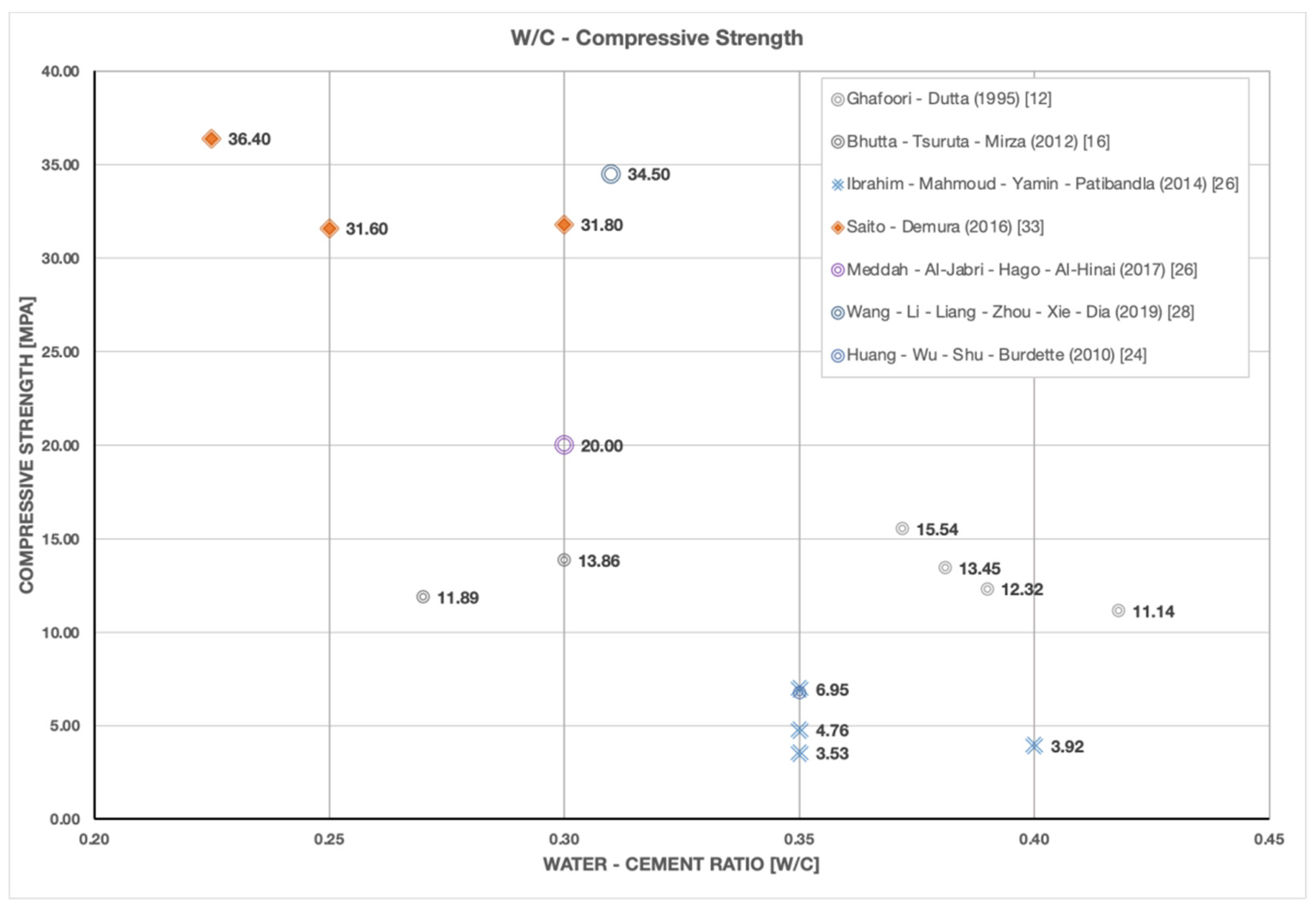
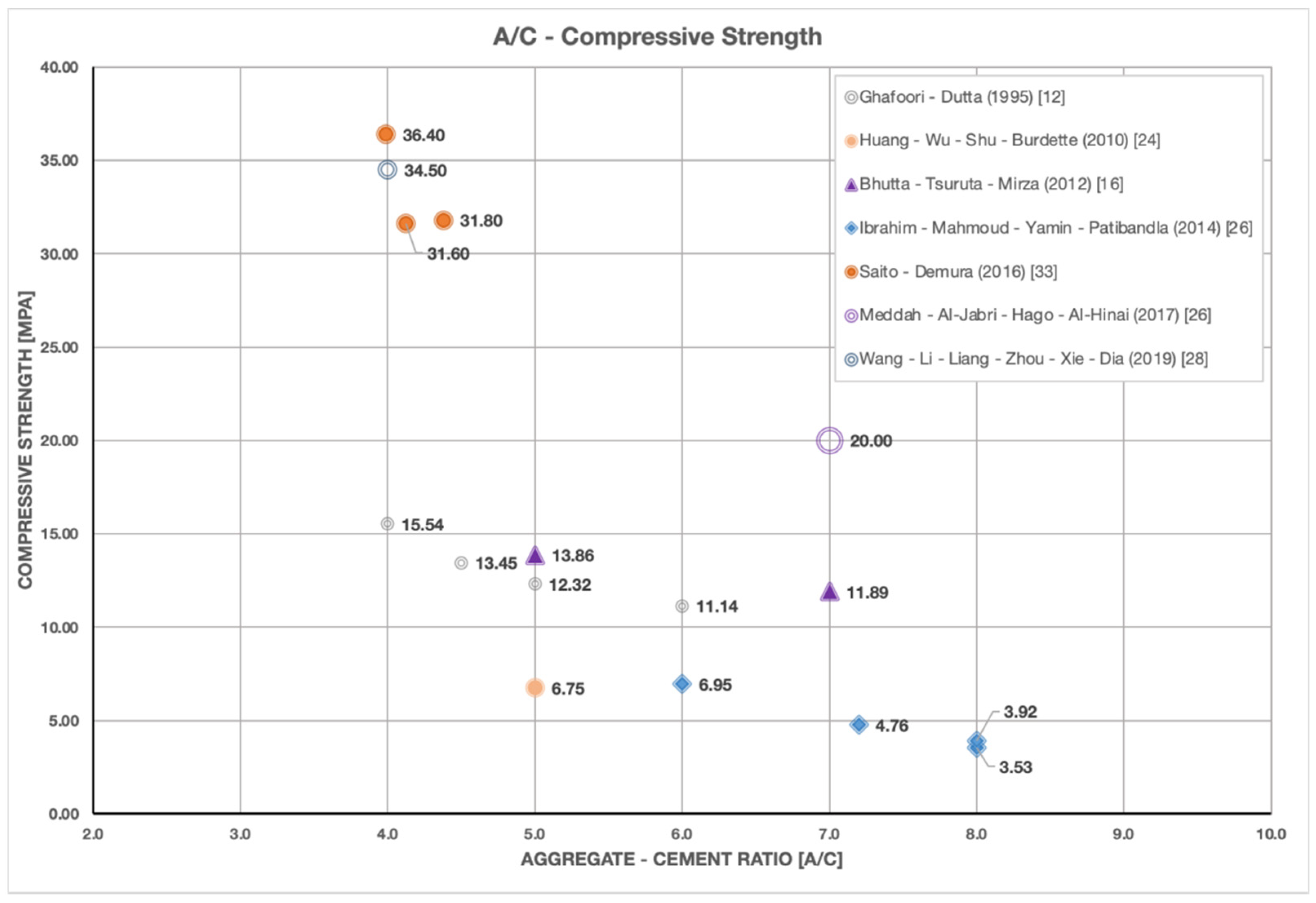
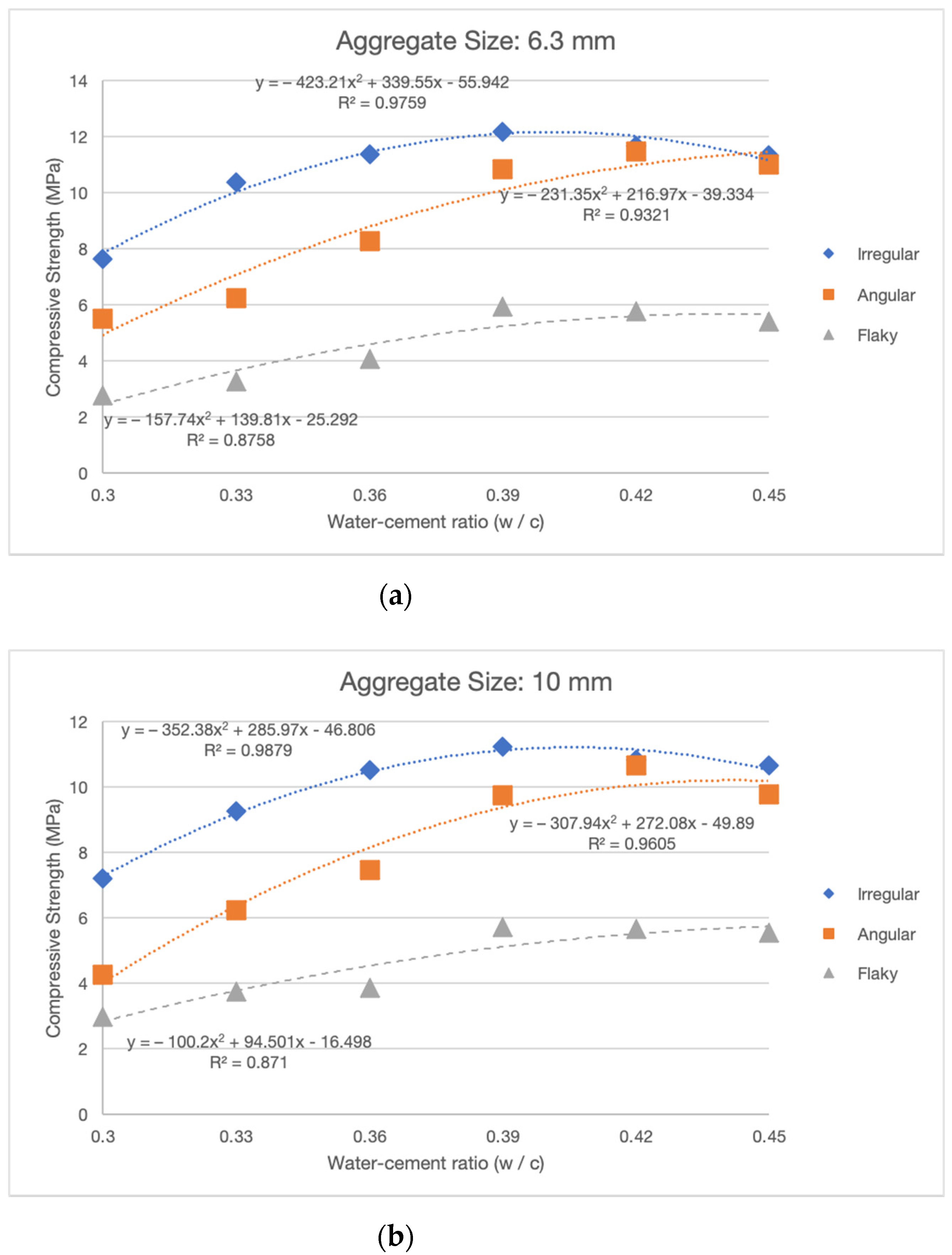
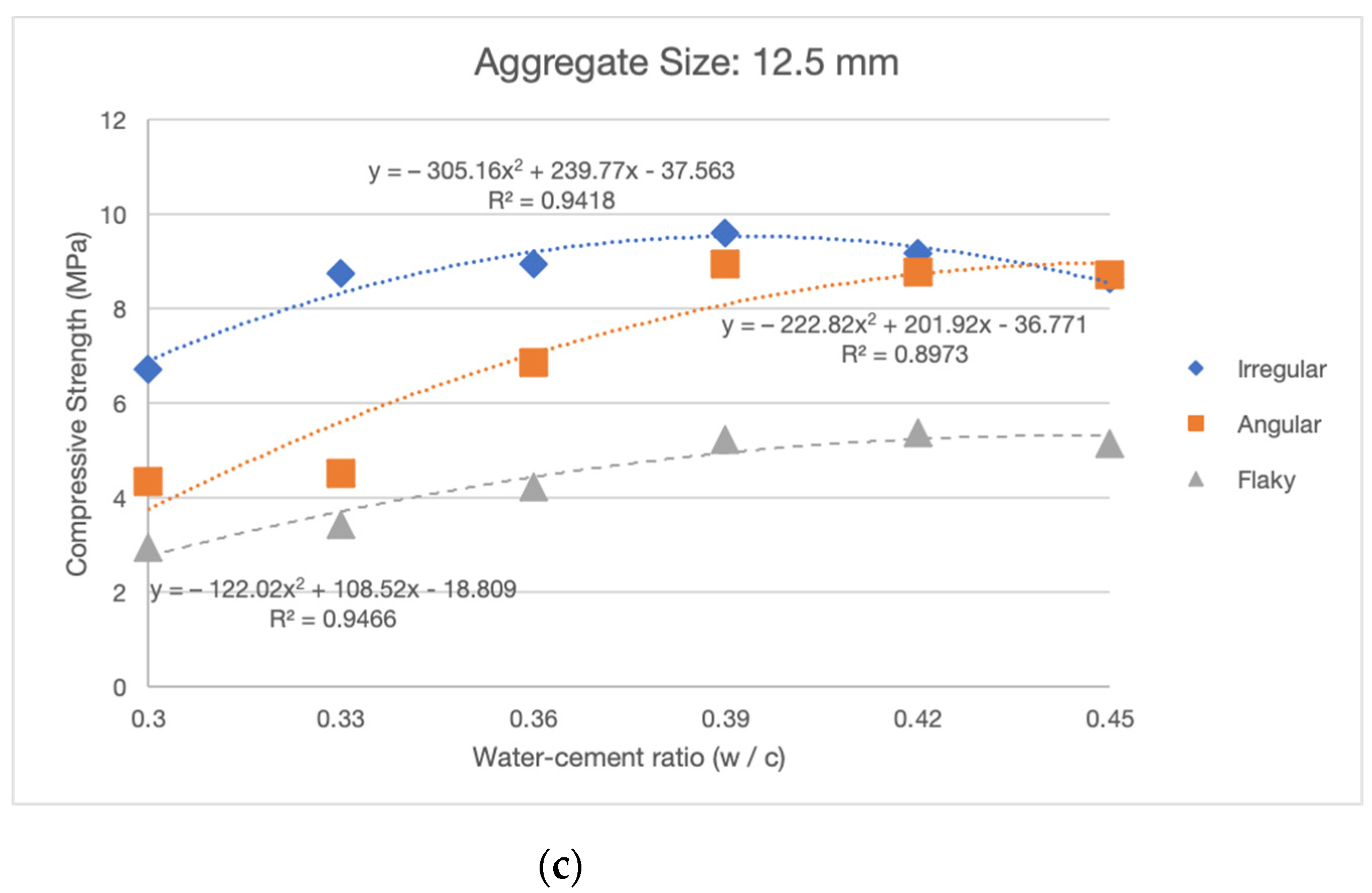
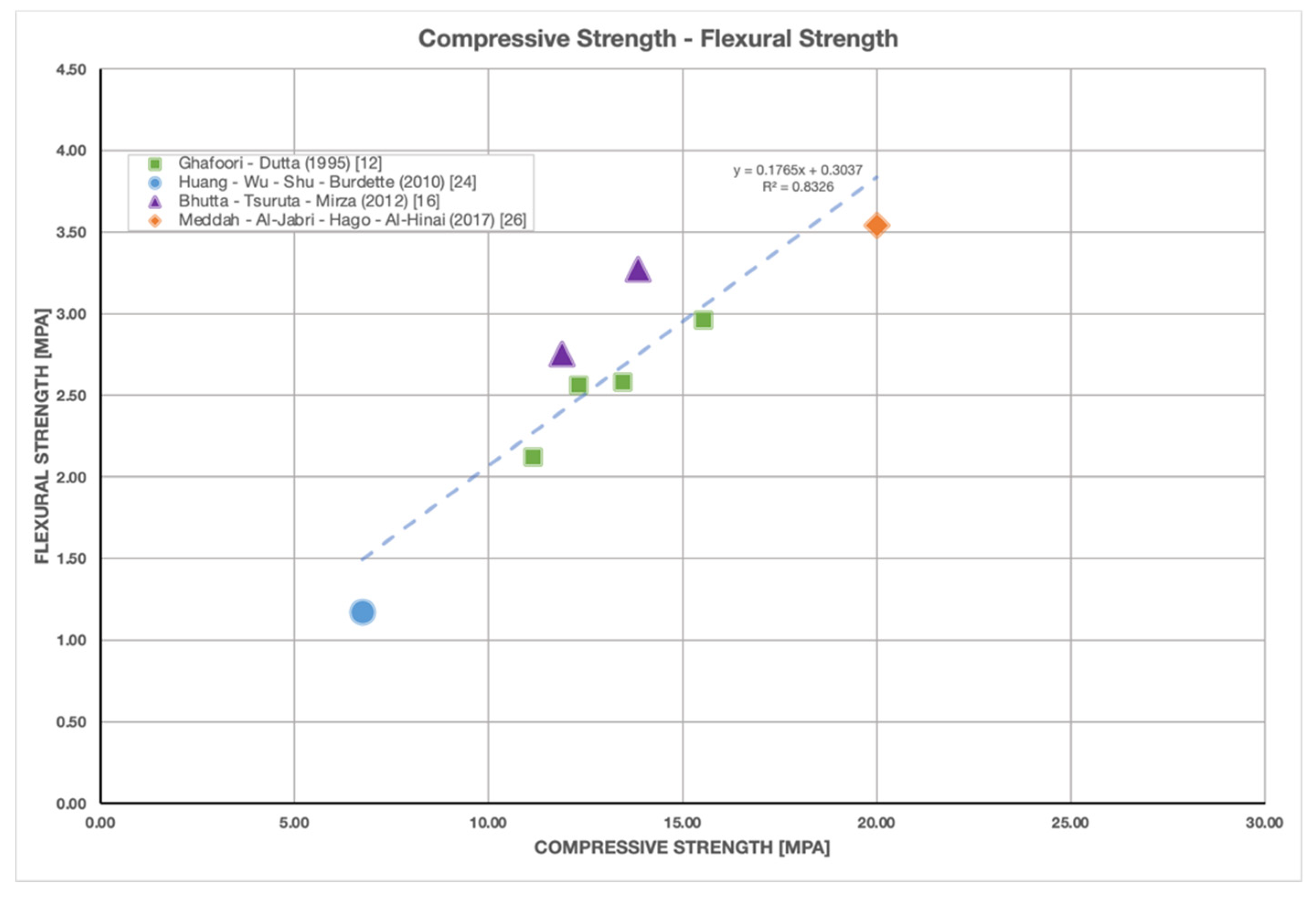
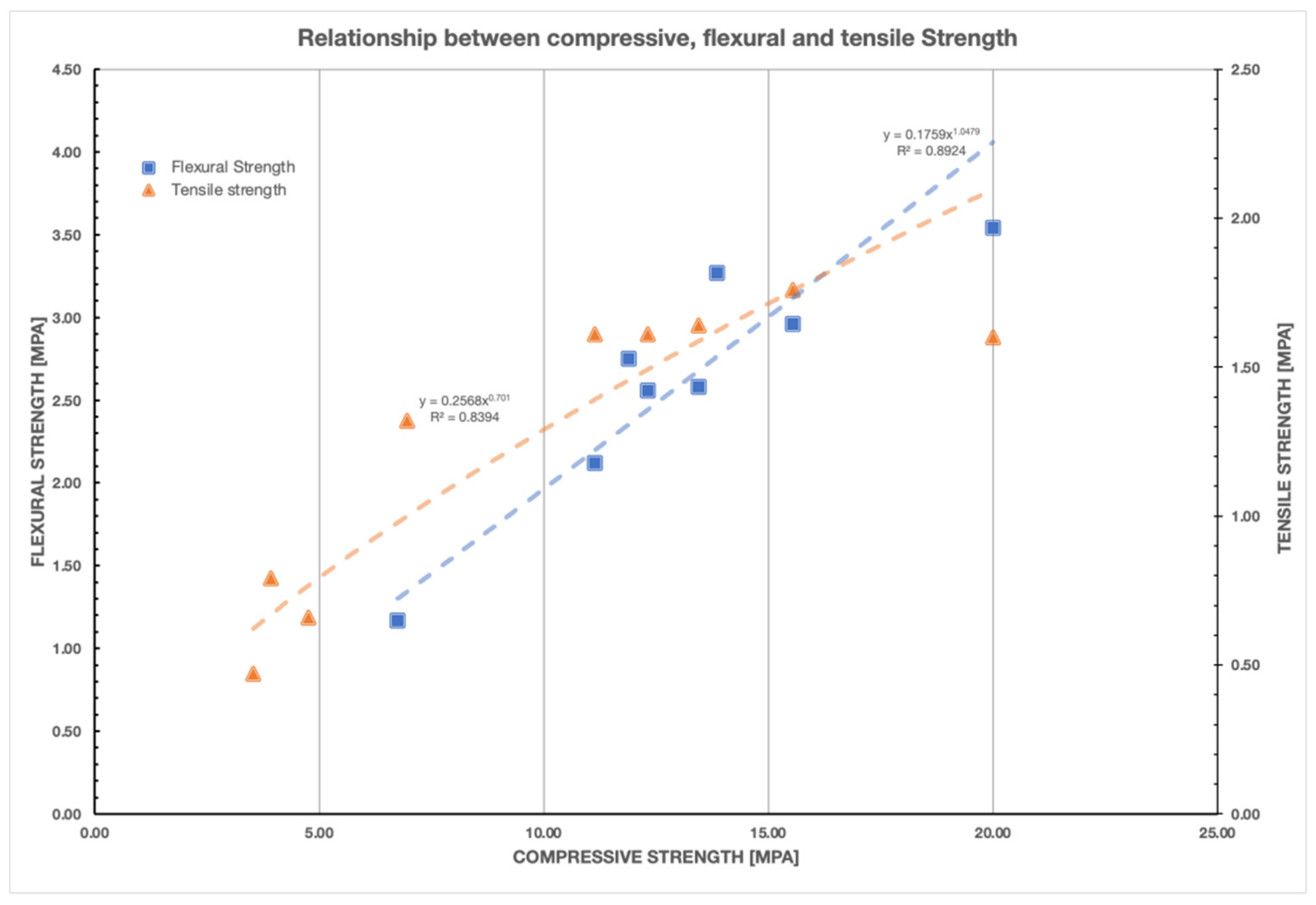
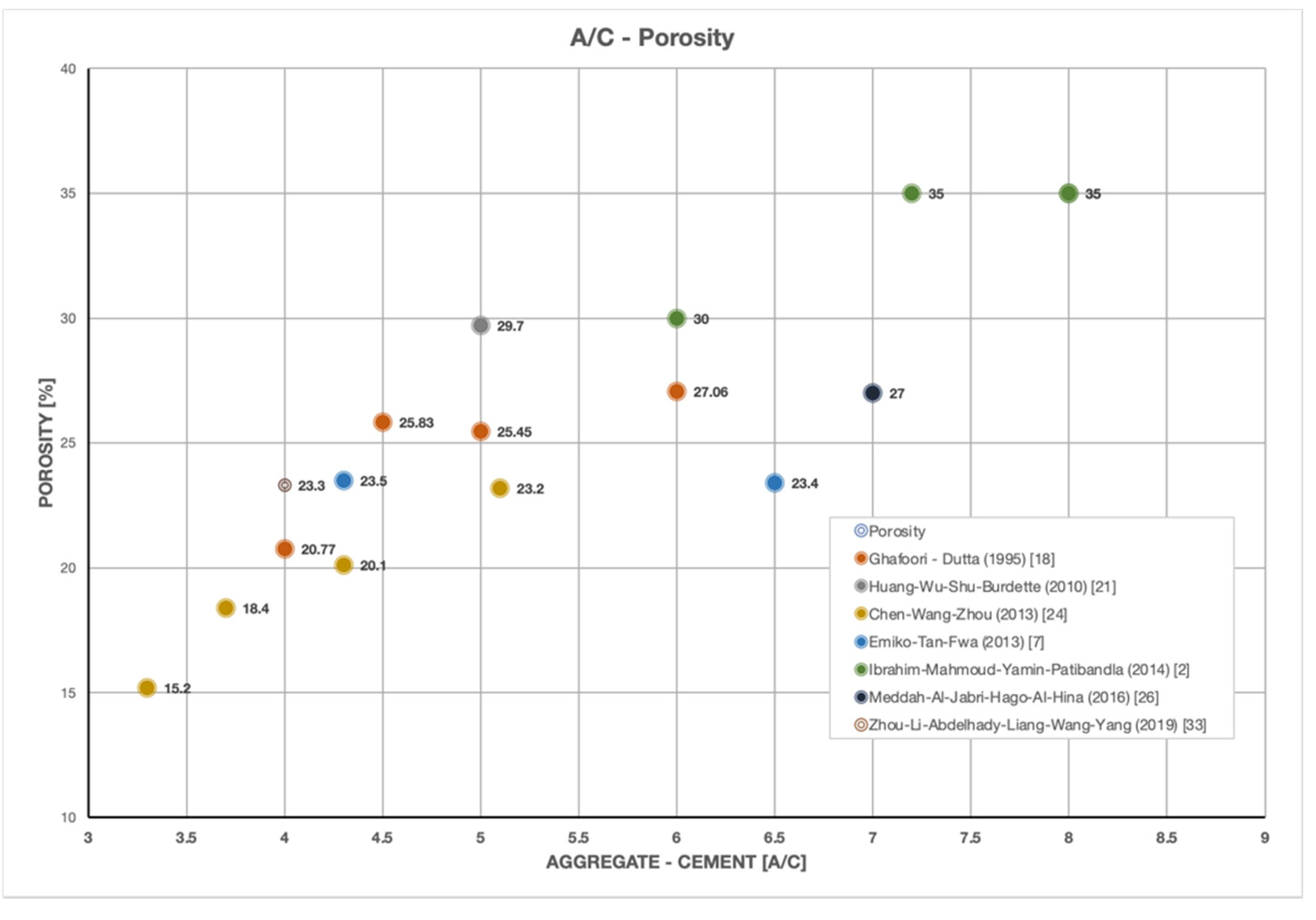
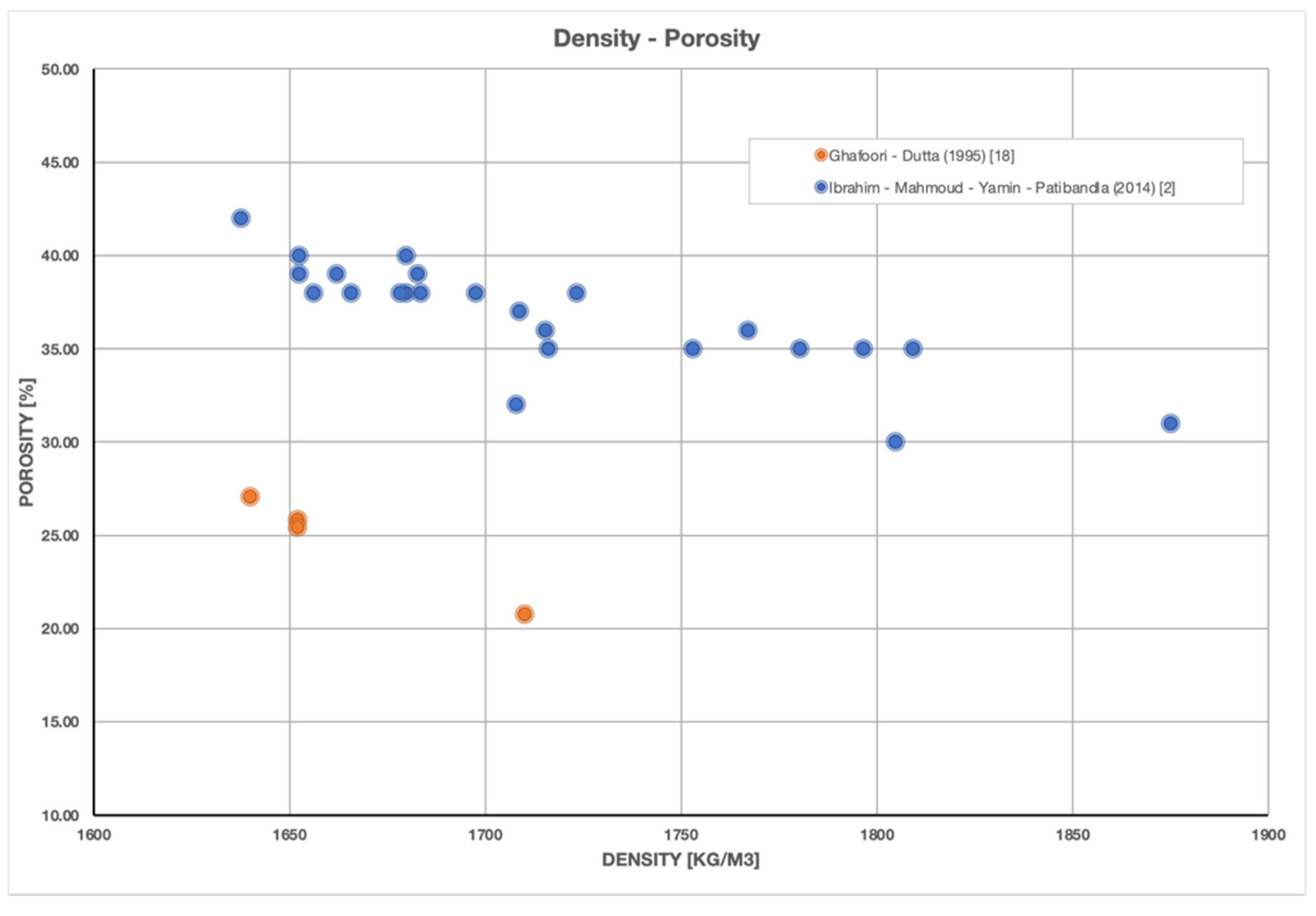
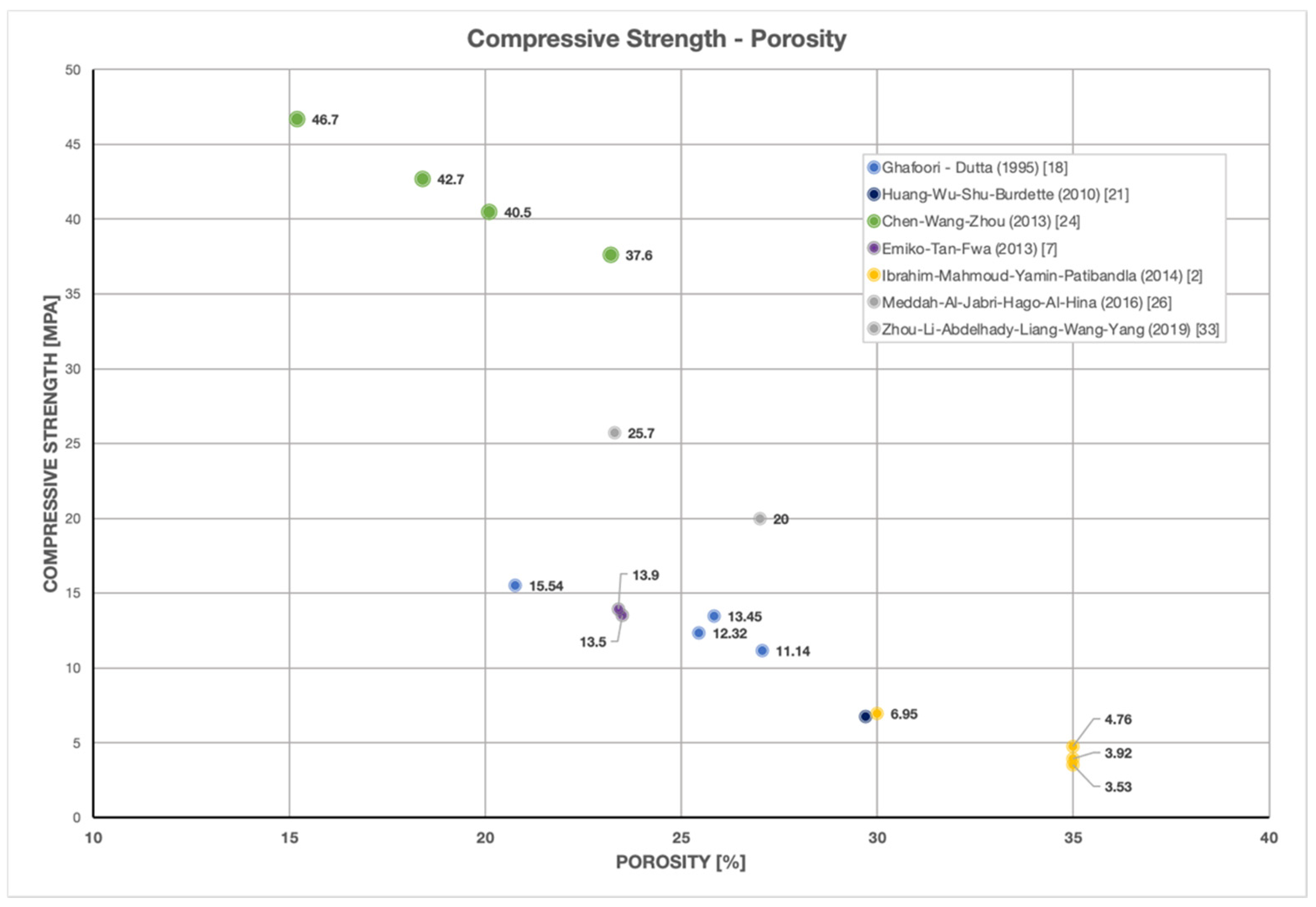
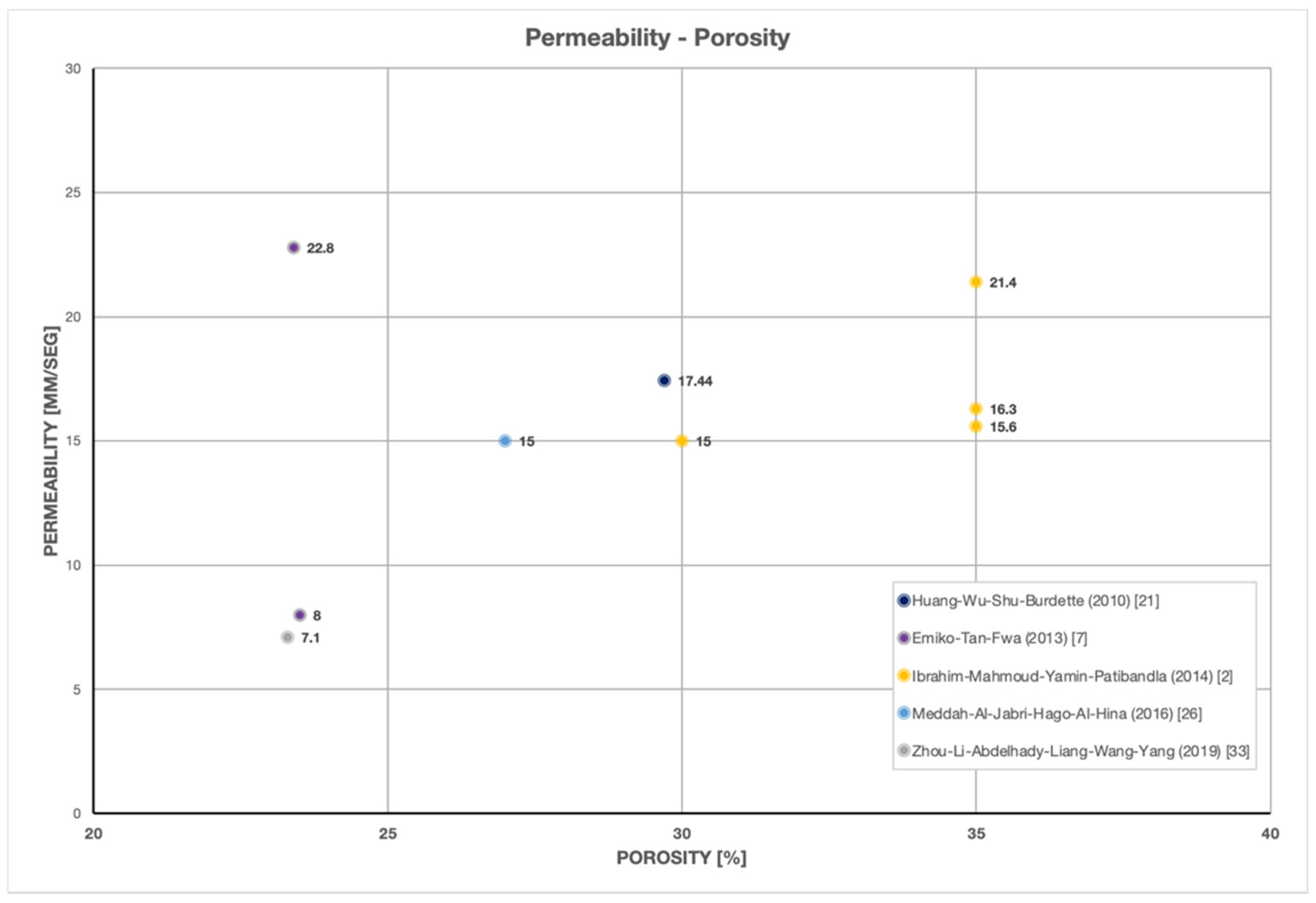
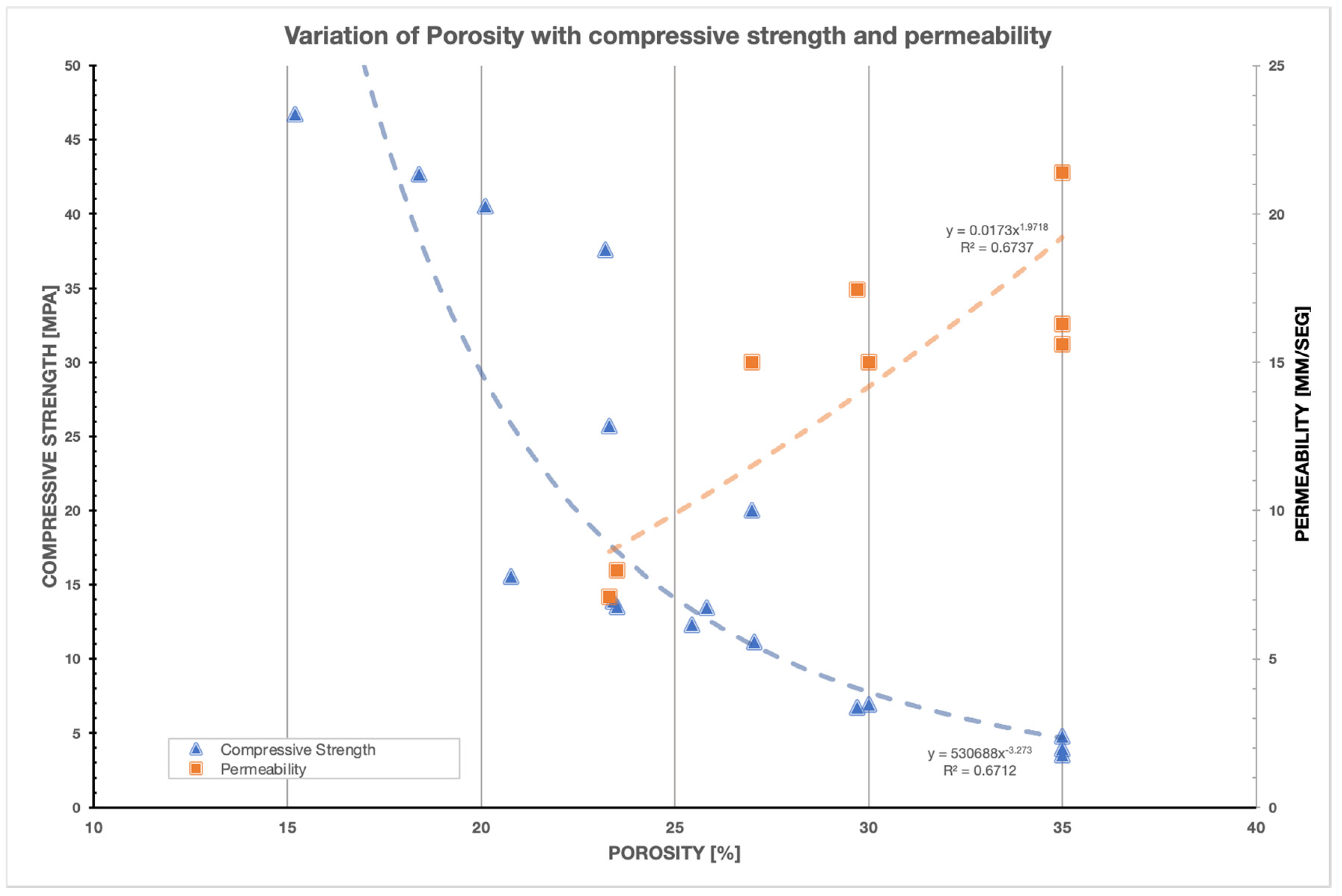
| Mix Proportion | Materials and Mixing Designs | Reference | |||||
|---|---|---|---|---|---|---|---|
| W/C * | Voids | A/C ** | Water | Cement | Fine Aggregate ≤2.5 mm | Coarse Aggregate 4.5 a 20 mm | |
| [%] | [kg/m3] | [kg/m3] | [kg/m3] | [kg/m3] | |||
| 0.37 | 23 | 4.0 | 154 | 413 | 1651 | [18] | |
| 0.38 | 26 | 4.5 | 143 | 376 | 1682 | ||
| 0.39 | 26 | 5.0 | 136 | 348 | 1740 | ||
| 0.42 | 28 | 6.0 | 125 | 300 | 1800 | ||
| 0.30 | 16 | 4.5 | 105 | 345 | 1542 | [19] | |
| 0.30 | 26 | 5.6 | 87 | 287 | 1620 | ||
| 0.28 | 20 | 10.1 | 50 | 180 | 1820 | [20] | |
| 0.27 | 20 | 6.5 | 70 | 260 | 1700 | ||
| 0.26 | 20 | 5.2 | 80 | 310 | 1620 | ||
| 0.27 | 20 | 4.8 | 90 | 330 | 1580 | ||
| 0.28 | 20 | 4.3 | 100 | 360 | 1550 | ||
| 0.26 | 20 | 4.0 | 100 | 380 | 1510 | ||
| 0.24 | 20 | 4.7 | 80 | 340 | 1600 | ||
| 0.30 | 20 | 4.8 | 100 | 330 | 1570 | ||
| 0.30 | 20 | 4.7 | 100 | 330 | 1560 | ||
| 0.35 | 4.5 | 112 | 320 | 1441 | [21] | ||
| 0.35 | 4.5 | 116 | 330 | 1487 | |||
| 0.35 | 4.5 | 123 | 353 | 1587 | |||
| 0.33 | 5.0 | 103 | 312 | 1559 | [22] | ||
| 0.33 | 5.0 | 104 | 314 | 1568 | |||
| 0.33 | 5.0 | 103 | 312 | 1558 | |||
| 0.33 | 5.0 | 101 | 305 | 1524 | |||
| 0.33 | 5.0 | 102 | 309 | 1546 | |||
| 0.33 | 5.0 | 102 | 309 | 1544 | |||
| 0.39 | 40 | 4.0 | 161 | 415 | 1658 | [16] | |
| 0.42 | 44 | 4.0 | 164 | 391 | 1563 | ||
| 0.27 | 27 | 5.1 | 85 | 320 | 1620 | [23] | |
| 0.27 | 22 | 6.9 | 70 | 260 | 1800 | ||
| 0.30 | 20 | 5.5 | 89 | 300 | 1640 | ||
| Mix Proportion | Materials and Mixing Design | Reference | |||||
|---|---|---|---|---|---|---|---|
| W/C * | Voids | A/C ** | Water | Cement | Fine Aggregate ≤2.5 mm | Coarse Aggregate 4.5 a 20 mm | |
| [%] | [kg·m−3] | [kg·m−3] | [kg·m−3] | [kg·m−3] | |||
| 0.30 | 4.3 | 110 | 367 | 1560 | [7] | ||
| 0.30 | 6.5 | 73 | 242 | 1560 | |||
| 0.33 | 3.3 | 145 | 440 | 1450 | [24] | ||
| 0.33 | 3.4 | 143 | 432 | 1472 | |||
| 0.33 | 3.6 | 137 | 416 | 1500 | |||
| 0.32 | 3.7 | 131 | 410 | 1532 | |||
| 0.32 | 4.0 | 126 | 394 | 1570 | |||
| 0.32 | 4.1 | 125 | 390 | 1591 | |||
| 0.30 | 4.3 | 113 | 378 | 1611 | |||
| 0.30 | 4.5 | 110 | 366 | 1637 | |||
| 0.30 | 4.8 | 104 | 345 | 1654 | |||
| 0.28 | 5.1 | 92 | 330 | 1668 | |||
| 0.28 | 5.2 | 91 | 325 | 1690 | |||
| 0.28 | 5.3 | 90 | 320 | 1702 | |||
| 0.35 | 8.0 | 70 | 200 | 1600 | [3] | ||
| 0.40 | 8.0 | 80 | 200 | 1600 | |||
| 0.35 | 7.2 | 88 | 250 | 1800 | |||
| 0.35 | 6.0 | 88 | 250 | 1500 | |||
| 0.23 | 10 | 4.0 | 88 | 392 | 247 | 1563 | [25] |
| 0.22 | 15 | 4.8 | 73 | 328 | 207 | 1563 | |
| 0.23 | 20 | 5.9 | 60 | 264 | 166 | 1563 | |
| 0.22 | 25 | 7.8 | 45 | 201 | 126 | 1563 | |
| 0.23 | 30 | 11.4 | 31 | 137 | 86 | 1563 | |
| 0.25 | 10 | 4.1 | 95 | 379 | 239 | 1563 | |
| 0.25 | 15 | 4.9 | 79 | 318 | 200 | 1563 | |
| 0.25 | 20 | 6.1 | 64 | 256 | 161 | 1563 | |
| 0.25 | 25 | 8.0 | 48 | 195 | 123 | 1563 | |
| 0.25 | 30 | 11.8 | 33 | 133 | 84 | 1563 | |
| 0.30 | 10 | 4.4 | 107 | 357 | 225 | 1563 | |
| 0.30 | 15 | 5.2 | 90 | 299 | 188 | 1563 | |
| 0.30 | 20 | 6.5 | 73 | 241 | 152 | 1563 | |
| 0.30 | 25 | 8.5 | 55 | 183 | 115 | 1563 | |
| 0.30 | 30 | 12.5 | 38 | 125 | 79 | 1563 | |
| 0.30 | 6.5 | 90 | 300 | 1957 | [26] | ||
| 0.30 | 6.7 | 90 | 300 | 2013 | |||
| 0.30 | 6.9 | 90 | 300 | 2070 | |||
| Mix Proportion | Mechanical and Physical Properties | References | ||||
|---|---|---|---|---|---|---|
| W/C | A/C | Density | Compressive Strength | Flexural Strength | Tensile Strength | |
| [kg·m−3] | [MPa] | [MPa] | [MPa] | |||
| 0.37 | 4.0 | 1710 | 15.54 | 2.96 | 1.76 | [12] |
| 0.38 | 4.5 | 1652 | 13.45 | 2.58 | 1.64 | |
| 0.39 | 5.0 | 1652 | 12.32 | 2.56 | 1.61 | |
| 0.42 | 6.0 | 1640 | 11.14 | 2.12 | 1.61 | |
| 0.35 | 5.0 | 6.75 | 1.17 | [21] | ||
| 0.39 | 4.0 | 12.18 | [16] | |||
| 0.42 | 4.0 | 11.47 | ||||
| 0.27 | 7.0 | 11.89 | 2.75 | [23] | ||
| 0.30 | 5.0 | 13.86 | 3.27 | |||
| 0.28 | 5.1 | 37.60 | 4.70 | [24] | ||
| 0.30 | 4.3 | 40.50 | 5.10 | |||
| 0.32 | 3.7 | 42.70 | 5.40 | |||
| 0.33 | 3.3 | 46.70 | 6.10 | |||
| 0.30 | 4.3 | 13.50 | 3.07 | [7] | ||
| 0.30 | 6.5 | 13.90 | 3.00 | |||
| 0.35 | 8.0 | 1716 | 3.53 | 0.47 | [3] | |
| 0.40 | 8.0 | 1753 | 3.92 | 0.79 | ||
| 0.35 | 7.2 | 1809 | 4.76 | 0.66 | ||
| 0.35 | 6.0 | 1805 | 6.95 | 1.32 | ||
| 0.23 | 4.0 | 36.40 | [25] | |||
| 0.25 | 4.1 | 31.60 | ||||
| 0.30 | 4.4 | 31.80 | ||||
| 0.30 | 7.0 | 20.00 | 3.54 | 1.60 | [26] | |
| 0.31 | 4.0 | 34.50 | [32] | |||
| Mix Proportion | Hydraulic Properties | References | ||||
|---|---|---|---|---|---|---|
| W/C | A/C | Density | Compressive Strength | Permeability | Porosity | |
| [kg·m−3] | [MPa] | [mm/s] | [%] | |||
| 0.37 | 4.0 | 1710 | 15.54 | 20.77 | [18] | |
| 0.38 | 4.5 | 1652 | 13.45 | 25.83 | ||
| 0.39 | 5.0 | 1652 | 12.32 | 25.45 | ||
| 0.42 | 6.0 | 1640 | 11.14 | 27.06 | ||
| 0.35 | 5.0 | 6.75 | 17.44 | 29.70 | [21] | |
| 0.39 | 4.0 | 12.18 | 0.03 | [16] | ||
| 0.42 | 4.0 | 11.47 | 0.41 | |||
| 0.27 | 7.0 | 11.89 | 23.13 | [23] | ||
| 0.30 | 5.0 | 13.86 | 4.94 | |||
| 0.28 | 5.1 | 37.60 | 23.20 | [24] | ||
| 0.30 | 4.3 | 40.50 | 20.10 | |||
| 0.32 | 3.7 | 42.70 | 18.40 | |||
| 0.33 | 3.3 | 46.70 | 15.20 | |||
| 0.30 | 4.3 | 13.50 | 8.00 | 23.50 | [7] | |
| 0.30 | 6.5 | 13.90 | 22.80 | 23.40 | ||
| 0.35 | 8.0 | 1716 | 3.53 | 15.60 | 35.00 | [3] |
| 0.40 | 8.0 | 1753 | 3.92 | 21.40 | 35.00 | |
| 0.35 | 7.2 | 1809 | 4.76 | 16.30 | 35.00 | |
| 0.35 | 6.0 | 1805 | 6.95 | 15.00 | 30.00 | |
| 0.23 | 4.0 | 36.40 | [25] | |||
| 0.25 | 4.1 | 31.60 | ||||
| 0.30 | 4.4 | 31.80 | ||||
| 0.30 | 7.0 | 20.00 | 15.00 | 27.00 | [26] | |
| 0.31 | 4.0 | 25.70 | 7.10 | 23.30 | [32] | |
| Aggregate | Mix Proportion | Properties | ||
|---|---|---|---|---|
| Size | W/C | A/C | Compressive Strength | Permeability |
| [mm] | [MPa] | [mm/h] | ||
| 10–6.3 | 0.39 | 4.0 | 12.18 | 122 |
| 12.5–10 | 0.39 | 4.0 | 11.23 | 152 |
| 16–12.5 | 0.39 | 4.0 | 9.60 | 176 |
| Aggregate | Mix Proportion | Properties | ||
|---|---|---|---|---|
| Size | W/C | A/C | Compressive Strength | Permeability |
| [mm] | [MPa] | [mm/h] | ||
| 10–6.3 | 0.39 | 4.0 | 11.47 | 1464 |
| 12.5–10 | 0.39 | 4.0 | 9.75 | 2314 |
| 16–12.5 | 0.39 | 4.0 | 8.95 | 2714 |
Publisher’s Note: MDPI stays neutral with regard to jurisdictional claims in published maps and institutional affiliations. |
© 2021 by the authors. Licensee MDPI, Basel, Switzerland. This article is an open access article distributed under the terms and conditions of the Creative Commons Attribution (CC BY) license (https://creativecommons.org/licenses/by/4.0/).
Share and Cite
Sánchez-Mendieta, C.; Galán, J.J.; Martinez-Lage, I. Physical and Hydraulic Properties of Porous Concrete. Sustainability 2021, 13, 10562. https://doi.org/10.3390/su131910562
Sánchez-Mendieta C, Galán JJ, Martinez-Lage I. Physical and Hydraulic Properties of Porous Concrete. Sustainability. 2021; 13(19):10562. https://doi.org/10.3390/su131910562
Chicago/Turabian StyleSánchez-Mendieta, Carlos, Juan Jose Galán, and Isabel Martinez-Lage. 2021. "Physical and Hydraulic Properties of Porous Concrete" Sustainability 13, no. 19: 10562. https://doi.org/10.3390/su131910562
APA StyleSánchez-Mendieta, C., Galán, J. J., & Martinez-Lage, I. (2021). Physical and Hydraulic Properties of Porous Concrete. Sustainability, 13(19), 10562. https://doi.org/10.3390/su131910562







